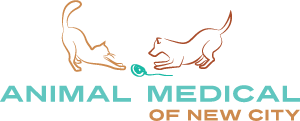The importance of pet nutrition in maintaining our pet’s health cannot be overstated. The industry has come a long way since the first dog biscuit was marketed in 1885; pet food sales are topping 15.7 billion which amounts to a 25% increase over the past 5 years. The latest boom has been in the organic food segment which has posted gains of 46% in 2005 and 36% in 2006 with no end in sight for new product lines. With the recent rash of pet food recalls, pet owners have begun to question the safety of commercial food sources and have turned to feeding raw food as a “healthier” alternative.
Don’t Demonstrate Love With Food
Regardless of the type of food being fed, it is apparent that owners reinforce the bond they have with their pet through the act of feeding; the problem is they are feeding too much food. It is estimated that approximately 44% of all house cats and 57% of all dogs are overweight or obese; this translates to 33 million dogs and 51 million cats that are overweight. Older dogs and smaller breeds appear to be more likely to be affected. Although 71% of cat owners and 60% of dog owners have acknowledged that their pets are overweight, many pet owners are not motivated to change this unhealthy pattern. Obesity leads to a variety of preventable conditions including type 2 diabetes mellitus, arthritis, respiratory difficulty, high blood pressure, heart disease and many forms of cancer.
Too Much Food, Not Enough Exercise
The major cause of obesity in pets is that daily caloric intake often exceeds the amount of calories that are metabolized. The solution is quite simple; eat less and exercise more. Since dogs and cats have yet to figure out how to use the can opener or open the refrigerator door, the “eating less” part of the equation should be straightforward. However, we are all guilty of underestimating the caloric content of the food that we consume. Most pet owners have no idea how many calories to feed their pet let alone how many calories are in the foods that they are feeding to their pets. In addition, spaying and neutering add a complicating factor by decreasing our pet’s metabolic rate by as much as 25%. Small dogs are at greatest risk because any increase in food intake is likely to be a greater percentage of their total daily requirement.
Domestication Aggrevates Obesity
Consider the unique feeding habits of cats and it is clear why our feline companions are overweight. Because cats are predatory and have relatively short intestinal tracts, they need to eat frequent small meals throughout the day. Working to capture their prey burns calories, which is hardly the case for a pampered sedentary house cat. Pet owners who need to share the feeding experience by catering to their cat’s seemingly finicky appetite perpetuates the overeating cycle.

Pet Weight Loss Ideas
The Association for Pet Obesity Prevention’s web site (www.petobesityprevention.com/index.htm) provides some excellent tools to aid in the weight loss process for pets and their owners. In addition, the following are some simple guidelines to begin to break the weight gain cycle.
- Determine your pet’s body condition score (BCS). If the score is greater than 3 then you need to act NOW. (http://www.petobesityprevention.com/weight_check.htm)
- Know the caloric content of your pet’s food; this includes all treats and table food. There are no neutral calories.
- Calculate the caloric requirements based on the desired weight of your pet. As a general rule, we multiply your pet’s weight in kilograms (pounds/2.2) by 30 and then add 70 ((weight (kg) x 30) + 70). This gives us the resting energy requirement (RER). For the overweight dog, we start with this number and reduce it based on the expected rate of weight loss of 3-5% per month. For cats we feed 80% of the calculated RER.
- Begin a regular exercise program, gradually increasing the intensity and frequency of effort over a 5-week period. Use the guidelines printed in last month’s Animal Medical of New City e-news.
- Reweigh your pet monthly to ensure the expected goals are being met. We recommend a veterinary supervised weight loss program, especially for our feline patients.
- In many cases, prescription diets may be necessary in order to achieve appropriate weight loss. If you would like more information about these diets, please contact us and a doctor or technician would be happy to discuss these diets with you.
